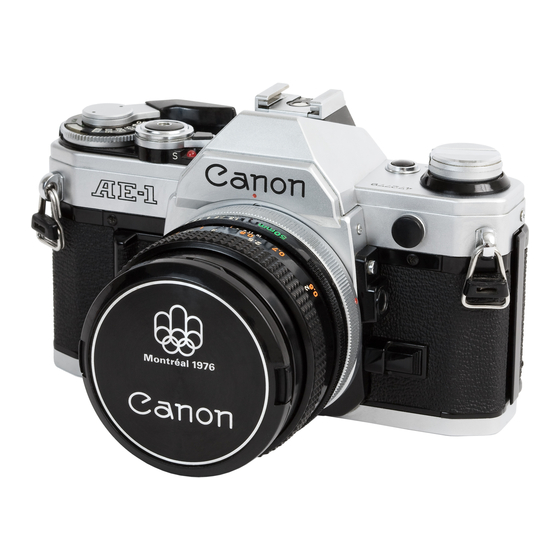Canon AE-1 Handbuch - Seite 11
Blättern Sie online oder laden Sie pdf Handbuch für Digitalkamera Canon AE-1 herunter. Canon AE-1 42 Seiten.
Auch für Canon AE-1: Erste Schritte (2 seiten), Anleitung Handbuch (22 seiten), Handbuch für Installationsverfahren (48 seiten), Handbuch (12 seiten), Anleitung Handbuch (22 seiten)

1.When a new battery is loaded.
2. When the shutter does not function.
3. When long exposures are frequently performed.
4. When the camera is used very frequently.
Usable Batteries: Silver Oxide Battery (6V ) (Eveready (UCAR) No.544, JIS 4G
13, Mallory PX 28; Alkaline Manganese Battery (6V) (Eveready (UCAR) No.537,
Mallory 7K l 3)
How to Check the Battery The charge level of the battery is checked by pressing the battery
check button on the top of the camera Carefully watch the meter needle in the viewfinder.
Press the battery check button and if the meter needle in the viewfinder rests below
the index, power level is sufficient. If the meter needle rests above the index, the
power level is insufficient. If this is the case, replace the battery with a new one of
the prescribed type. When a new battery with full voltage is used, the meter needle
in the viewfinder indicates close to the 2.8 f/stop. When the battery power wanes, it
takes more time for the meter needle to stop fluttering.
Because of the special circuit, the meter needle's swing depends on the state of the battery.
The meter needle will rise as the battery power wanes until it reaches the f/5.6 position where
there is no longer any more power. Press the battery check button until the meter needle rests
still. When the battery is just about to fail, the meter needle in the viewfinder rests close to the
index.
5. Loading the Film The Canon AE-1 uses color or black and white film in standard 35mm
cartridges. Since this is a 25 years old camera, you can't expect it is as convenient as today's
modern SLR with nifty feature such as Auto DX coding , auto film advance and power
rewind. Most of this procedures have to handle them manually.
5. When the camera is used after it has been stored for a long period.
When the camera is used in extremely cold conditions.
